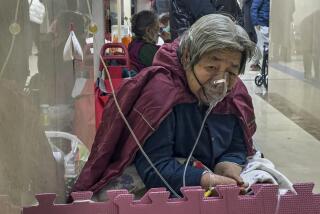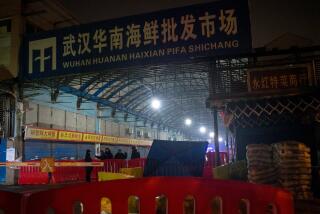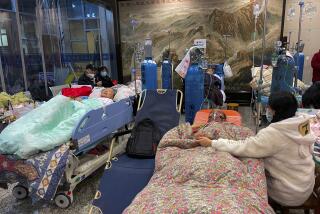China’s Bird Flu Policy Is Under a Microscope
XIANGTAN, China — Dai Aixiu, 41, leans against her doorpost and watches as a dozen chickens and ducks peck at small bugs beside a broken urn in the garbage-littered yard. Her front door is open, and the birds sometimes enter the house, leaving behind droppings and feathers before she shoos them out.
As the world grows increasingly concerned about the prospect of a global avian influenza pandemic, China remains a huge question mark. The Asian giant has long been seen as a disease incubator, given its dense population, unsanitary conditions, exotic animal diet and thousands of years of people and poultry living in close proximity.
China has repeatedly said there is nothing to fear. “We’ve learned our lesson from SARS,” said Jiang Suchun, a Beijing specialist on contagious diseases such as the severe acute respiratory syndrome that struck the nation hard in 2003. “We’re better prepared. We’ve adopted methods of separation that are quite effective. I’m rather optimistic.”
That may be the case. But China is not giving the global community a lot of cause for optimism. Even as its neighbors in Vietnam, Thailand, Cambodia and Indonesia have witnessed more than 60 deaths from avian flu since late 2003, China has reported no cases of transmission to humans.
Until this weekend, authorities had called a 12-year-old girl’s death last month from a respiratory illness here in Xiangtan, in Hunan province, a routine case of pneumonia.
Only on Sunday did China acknowledge that the avian flu virus H5N1 might have been the culprit, and it asked the World Health Organization for help in investigating the case, according to the official New China News Agency.
Beijing sought to reassure the world that it was in control of the situation with the unveiling last week of a $248-million initiative by Premier Wen Jiabao, signaling a political commitment from the top. China pledged more aggressive disease monitoring, stepped-up punishment for those failing to report outbreaks and an accelerated vaccination research program.
The announcement came two weeks before President Bush was due to arrive in Beijing for a high-profile summit, with contagious diseases expected to be high on the agenda. It also followed by a day Bush’s unveiling of a $7.1-billion contagious-disease initiative, which included $251 million to help bolster surveillance in developing countries.
The avian flu issue underscores the evolving relationship between the U.S. and China, as risks and ties increasingly extend beyond the military and the economy.
“Talk is easy, talk is cheap,” said Guan Yi, a professor at the University of Hong Kong medical school and an expert on the H5N1 virus. “If there’s a problem in Southeast Asia, it’s the same in China.”
Beijing has been slow to share information with outside experts, leading some to wonder whether the country can transcend a centuries-old bureaucratic culture of secrecy that could see the H5N1 virus gain a significant foothold in the human population before experts are even aware of the problem.
As the political will in the U.S. to address the infection risk has stiffened, the Defense Department and other parts of the government are paying more attention to China’s potential role in nurturing and spreading a future pandemic.
“Basically for D.C., it’s a transparency problem,” said Bates Gill, a China specialist at the Center for Strategic and International Studies in Washington. “They want China to be a lot more open and accurate in the way epidemics are reported, and a lot more open in the access granted to American and international experts who could help China push it back.”
Some believe the biggest problem may not be China’s central government, which ultimately moved decisively against SARS in 2003, but corrupt local officials siphoning off money meant for prevention or hiding a local outbreak, fearful that it might hurt their chance of a promotion.
China has reported four outbreaks of bird flu in recent weeks: the one in Xiangtan and others in Anhui and Liaoning provinces and in Bayan Township in Inner Mongolia. This follows a swine flu outbreak during the summer that China tried to cover up, which killed at least 34 people.
Liu, a resident of Bayan Township who would only give his surname, said many residents cried when government officials seized their chickens because of the effect on their livelihood. He said he doubted that many would receive the official $1.20-per-bird compensation. Local officials tend to have sticky fingers, he said, citing the village head’s recent arrest on suspicion of embezzling $110,000 from road project funds.
At a checkpoint erected at the edge of Xiangtan recently, tires on outgoing cars were sometimes disinfected by a man in a biohazard suit sitting on a roadside chair, and at other times not.
Inside the affected area, it was evident that the outbreak had also hit the economy. This street would normally be jumping, a local taxi driver said, pointing to a string of shuttered offices and empty shops.
At his restaurant at one end of town, Feng Yong, 24, cooked lunch for his family. Without customers, he sits and waits, hoping business will pick up.
Down the street, Yang Aitao, 50, owner of a veterinary drug store, said even her sales were down. “The government brings in its own medicine, so nobody buys ours,” she said.
Local residents gathering to talk about the outbreak say that at this point, the situation is far better than during the SARS outbreak, when local markets closed and fearful residents blocked strangers from entering town.
But two residents who asked not to be identified said the 12-year-old girl in the news wasn’t the only one to die from respiratory illness, that someone caring for her also died around the same time. The reports could not be confirmed.
Some residents also charged that local officials who seized their chickens in Xiangtan siphoned off as much as a third of the compensation, billing it as a “slaughtering fee.” Even if paid in full, the amount would cover less than half of the price that chickens go for in the market.
Epidemiologists say farmers who do not receive fair compensation for their culled flocks may be tempted to smuggle the birds out of the affected area to sell or give them to relatives, increasing the risk of disease spreading.
After news of the girl’s death surfaced, Beijing sharply restricted local reporting on avian-flu-related issues. Newspapers nationwide have been ordered to carry nearly identical stories with little analysis, a common practice when an issue becomes politically sensitive.
Efforts by a foreign journalist to report on the local situation were cut short by the arrival of several undercover police. Most laws and regulations in China are vague and often give authorities broad leeway to block potentially embarrassing reports.
Three hours of interrogation by city, county and national propaganda and security officials followed, along with an order to leave the area. “Why don’t you just believe the New China news service?” a propaganda officer demanded at one point.
China is of particular concern among contagious-disease specialists because several of the major epidemics during the 20th century were linked to southern China, said Kennedy Shortridge, a University of Hong Kong professor emeritus.
The global and regional stakes have increased in recent years with the rise of chicken farming on an industrial scale, providing a potentially rich breeding ground for the disease. Qi Xiaoqiu, China’s disease control director, said in Washington last week that Beijing was aware of the risk, given its domestic poultry population of 14 billion, 20% of the world’s total.
“Even though it’s a slow system, we have the ability to learn,” said Xu Xianglin, professor of government at Peking University. “It’s not as if we’re not doing anything, as some in the West believe.”
*
Ding Li in The Times’ Beijing Bureau contributed to this report.
More to Read
Sign up for Essential California
The most important California stories and recommendations in your inbox every morning.
You may occasionally receive promotional content from the Los Angeles Times.










